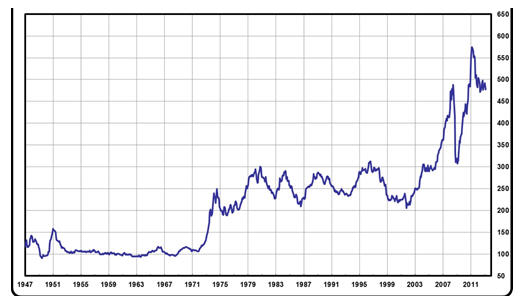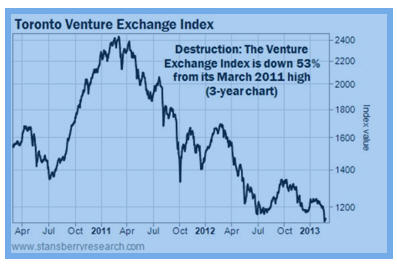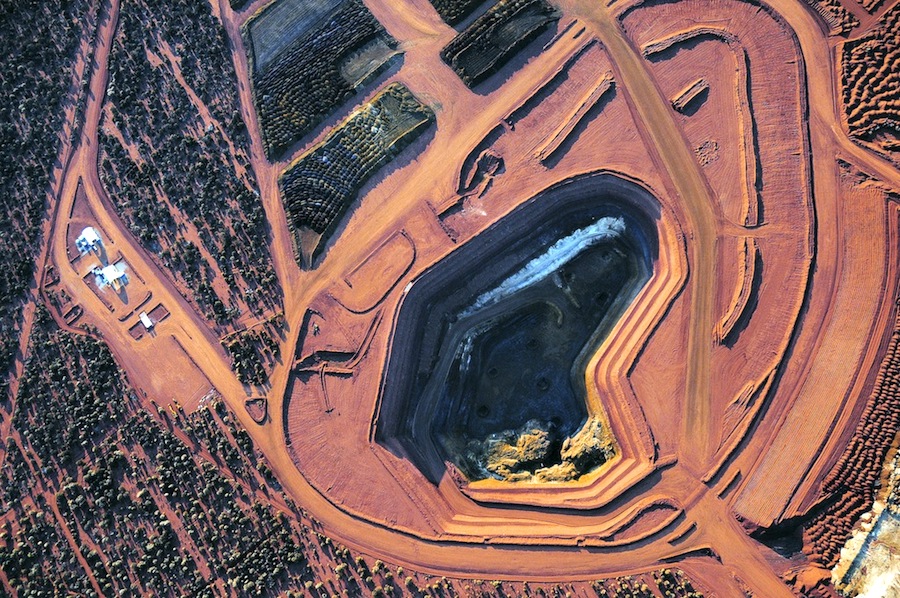Central banque royales

There are three precious metal and commodity truths not yet universally recognized:
- Gold and silver are money, are the only true money. Today what is called money – fiat – is not money, it’s credit brought into existence by a computer key stroke
- For the last 13 years true wealth hasn’t been garnered from the accumulation of fiat money but from gold and silver, this will continue.
 Gold has gone from an average of $284 to $1570.90 ($1570.90/$284 = 5.5x) since January 2000. During the same time frame silver has gone from an average of $4.95 to $28.62 ($28.62/$4.95 = 5.7x) per oz. In January 2000 the gold/silver ratio was $284.32/$4.95 = 57.43 Today, the gold/silver ratio is 54.88. Silver, a.k.a. ‘poor man’s gold’ trades in lockstep with gold
Gold has gone from an average of $284 to $1570.90 ($1570.90/$284 = 5.5x) since January 2000. During the same time frame silver has gone from an average of $4.95 to $28.62 ($28.62/$4.95 = 5.7x) per oz. In January 2000 the gold/silver ratio was $284.32/$4.95 = 57.43 Today, the gold/silver ratio is 54.88. Silver, a.k.a. ‘poor man’s gold’ trades in lockstep with gold
- Commodities have been a very good place for investors to be
Monetary and fiscal authorities around the world are setting us up for an inflationary cycle. This will be the ultimate driver of the precious metals and general commodities bull market going forward. Inflation means stronger commodities and precious metals because of weaker currencies. Below is a chart of the CRB BLS Spot Index from January 1947 to February 2013. The Spot Market Price Index is a measure of price movements of 22 basic commodities.  Inflation is caused by an increase in the money supply – the rate of inflation is determined by the quantity of goods vs. the money supply – more money chasing the same amount of, or fewer goods, causes price increases. Each currency unit created makes those already in existence worth a little less.
Inflation is caused by an increase in the money supply – the rate of inflation is determined by the quantity of goods vs. the money supply – more money chasing the same amount of, or fewer goods, causes price increases. Each currency unit created makes those already in existence worth a little less.  When returns are looked at via inflation, and priced in gold, they do not look quite as rosy as pictured by the mainstream media.
When returns are looked at via inflation, and priced in gold, they do not look quite as rosy as pictured by the mainstream media.  What’s important here, right now, is to ask ourselves if we need gold to continue to do what’s it’s done for thousands of years and of course has done so spectacularly for the last thirteen. Do we still need to own gold and silver to protect our purchasing power and act as a safe haven in times of trouble? Or is gold’s role finished, has it done its job and we can forget about it till the next great devaluation? Let’s consider a few facts:
What’s important here, right now, is to ask ourselves if we need gold to continue to do what’s it’s done for thousands of years and of course has done so spectacularly for the last thirteen. Do we still need to own gold and silver to protect our purchasing power and act as a safe haven in times of trouble? Or is gold’s role finished, has it done its job and we can forget about it till the next great devaluation? Let’s consider a few facts:
- Current global government debt is $50,155,731,484,966.00
- Currency and credit derivatives are $626 trillion
- Global conflicts are intensifying and raising already considerable tension levels
- Zero interest rates, global quantitative easing and escalating currency wars – an international race to worthless that ends with everyone a loser and leads to a rise in protectionism and future trade wars
- Current U.S. Debt – the world’s reserve currency – is $16,681,595,900.00. This page is a must view.
Gold and commodities went up because of massive global wide money creation. The price of gold soared to U.S. $1900 per ounce, gold’s price (and commodity prices) got ahead of the money creation and suffered a nasty, but necessary, correction.
Money creation – a decade long currency war – is not going to stop, there’s a race to worthless underway and it means massive global money creation. Every country that exports goods will participate, each trying to beggar their neighbor in an attempt to get the world to buy their goods.
What’s the future for precious metals and commodities prices? Up. I’m not going to hedge myself, there’s no ifs here, I believe precious metals and commodities are going higher. PERIOD.
The Mississippi Bubble – history might not repeat but it sure enough rhymes
In 1715 France was bankrupt. John Law (yesteryears John Maynard Keynes), a Scottish playboy, gambler and amateur economist thought he had the answer to France’s financial woes. Law convinced the powers that be to give him the opportunity to put into practice his theory – that gold and silver were too scarce and inelastic to serve as money.
Under his proposal France was to adopt a paper monetary system. Law immediately set up a private bank which two years later became France’s central bank, the Banque Royale (today’s world’s central banks), whose notes circulated as money, and a holding company, the Mississippi Company (today’s stock markets), whose shares soon traded at values inflated by the new paper money.
 The Banque Royale issued almost three billion livres in banknotes in two years even though they did not have anywhere near the equivalent amount of gold and silver for redemptions.
The Banque Royale issued almost three billion livres in banknotes in two years even though they did not have anywhere near the equivalent amount of gold and silver for redemptions.
The Mississippi Company attained a market capitalization of five billion livres.
There was a massive stock market bubble, a parabolic blow-off, a bubble collapse, a bank failure and Law was on the run.
John Law’s Mississippi Bubble was a direct result of his failed monetary policies causing excessive money supply growth and inflation.
This picture (John Law making fiat from hard money – ‘Once and Future Money’ by Bob Landis) shows French contempt for Law’s fiat, and I suppose history’s as well for no fiat currency has ever survived.
“The paper notes of the Bank Royale were made legal tender, which meant that they could be used to pay taxes and settle most debts. The company was trying to get people to accept the paper notes rather than gold.” Jon Moen, John Law and the Mississippi Bubble: 1718-1720
Investors are starting to realize that gold is a storehouse of value and a safe haven in times of turmoil. Gold’s price has risen because of the abuse and mismanagement of our monetary and currency systems – throughout history, gold has always shone the brightest when trust breaks down, confidence falls and fear climbs.
Urbanization is the driving force behind global commodities demand and inflationary pressures have moved from commodity inflation to core inflation. Both urbanization and inflation are set to continue for the foreseeable future.
Conclusion
Historically junior resource companies have offered investors the greatest leverage to rising precious metals and commodity prices. There is also a very real and increasing trend for Mergers and Acquisitions (M&A) in the resource sector.
 Remember, our junior resource companies, the same ones who today are so oversold and undervalued, are the present owners of the world’s future precious metals and commodities supply.
Remember, our junior resource companies, the same ones who today are so oversold and undervalued, are the present owners of the world’s future precious metals and commodities supply.
Two ways to mitigate risk for investors is to buy at market bottoms and have a long-term view of their investments to take advantage of a company’s increasing value as its projects move through exploration and development.
Other than picking up some more gold and silver bullion I’m concentrating on identifying and buying a few quality junior resource companies as investment vehicles to take advantage of what I think I know regarding the future for precious metals and commodities.
There are a dozen high quality juniors on my radar screen – are there a few junior resource companies, with exceptional management teams operating in politically safe jurisdictions, on your radar screen?
Contact Richard (Rick) Mills via rick@aheadoftheherd.com
Richard is the owner of Aheadoftheherd.com and invests in the junior resource/bio-tech sectors. Get in touch with him if you’re interested in learning more about the junior resource and bio-med sectors, and quality individual company’s within these sectors.
His articles have been published on more than 400 websites, like the Wall Street Journal, Market Oracle, USA Today, National Post, Montreal Gazette, Vancouver Sun, CBS news, Calgary Herald, Resource Investor, Forbes and Financial Sense.
For Richard Mills’ legal notice/disclaimer, see Aheadoftheherd.com
More News
Lynas climbs as trade war roils global markets
April 11, 2025 | 03:02 am
Trade war risks copper investments needed to meet future demand
April 10, 2025 | 03:55 pm
{{ commodity.name }}
{{ post.title }}
{{ post.date }}





Comments